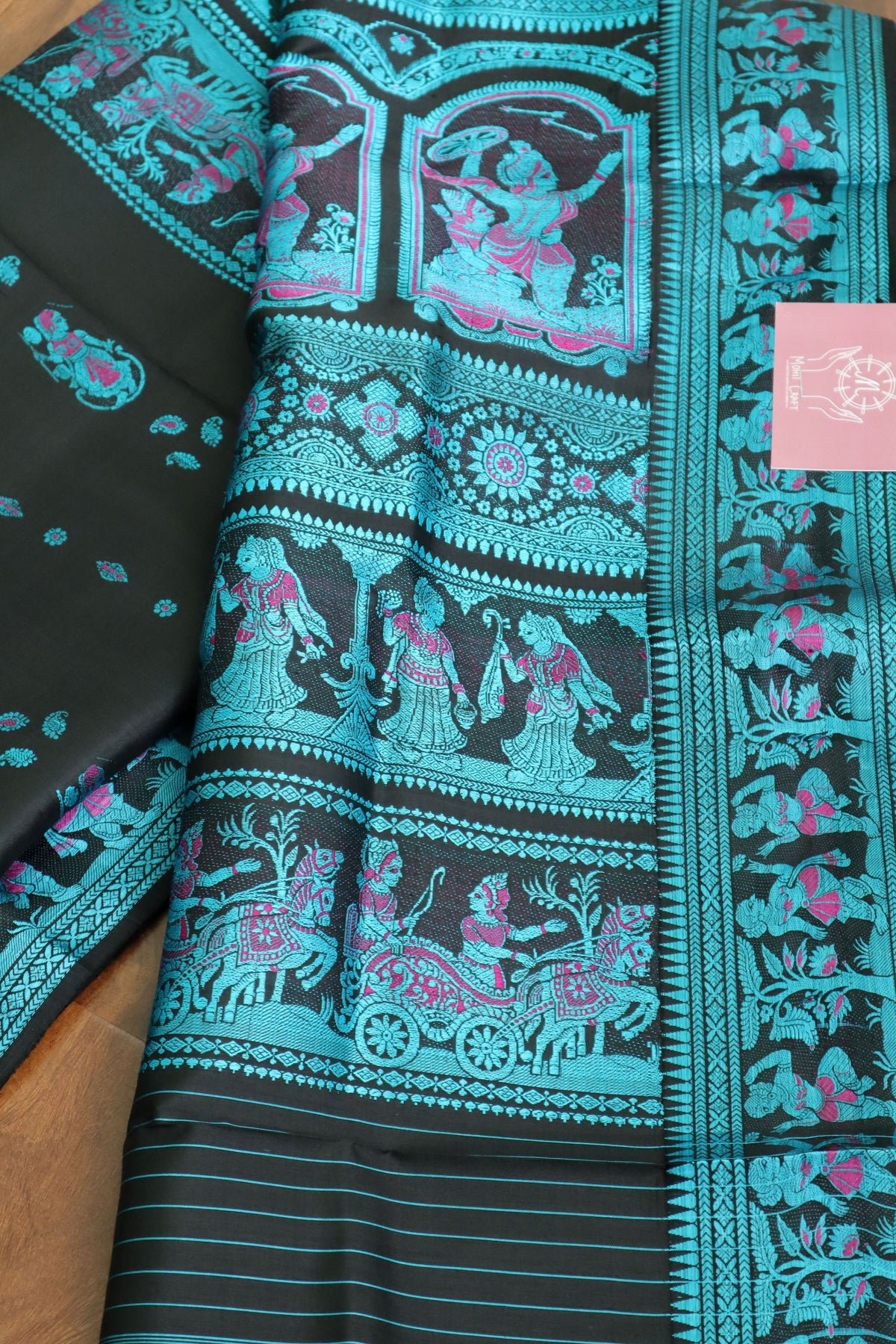When we think of Indian textiles, several names immediately come to mind, but few can match the elegance and grandeur of Baluchari Silk. This luxurious fabric, deeply rooted in the cultural history of Bengal, has been synonymous with opulence, craftsmanship, and rich storytelling for centuries. In this blog, we’ll dive into the fascinating world of Baluchari Silk—its history, craftsmanship, designs, and modern-day relevance.
What is Baluchari Silk?
Baluchari Silk is a traditional handwoven fabric made from pure silk, known for its intricate and detailed brocade weaving technique. Originating from the small town of Baluchar in Murshidabad, West Bengal, this fabric has earned a global reputation for its rich, elaborate designs that reflect Indian culture, mythology, and history. Initially, Baluchari was woven using cotton threads, but over time, silk became the preferred material for creating these masterpieces.
The History and Evolution of Baluchari Silk
The origins of Baluchari Silk can be traced back to the 18th century, during the reign of Murshid Quli Khan in Bengal. The technique of weaving with silk was introduced during the Mughal era, which led to the rise of more sophisticated and intricate weaving methods in Bengal.
The weaving tradition flourished under the patronage of the Mughal emperors and the later Maratha rulers of the region. By the time of the Bishnupur period in the 19th century, Baluchari silk reached new heights of elegance. The weavers of Bishnupur, especially, became renowned for their artistic excellence, and it is here that Baluchari began to take its current form.
Craftsmanship Behind Baluchari Silk
Baluchari Silk’s beauty lies in its weaving process. It’s produced using the brocade weaving technique, where patterns are woven directly into the fabric. This intricate craftsmanship requires an incredible level of skill and precision.
Baluchari Silk is usually made with pure mulberry silk threads, which gives the fabric its luxurious feel and sheen. Weavers use a special jacquard loom to create the detailed motifs, which often feature scenes from mythology, folklore, royal portraits, and more.
The process can take several days, sometimes even weeks, to complete one piece of fabric, depending on the complexity of the design. This is why Baluchari is considered a highly prized textile, often passed down from generation to generation.
Designs and Motifs in Baluchari Silk
One of the most distinctive features of Baluchari Silk is its designs. The fabric is adorned with intricate motifs, which are typically inspired by mythological stories, religious symbols, nature, and royal portraits. These designs are not just decorative but often carry a deeper cultural or historical significance.
Common Themes and Motifs:
- Mythological Narratives: Many Baluchari saris feature stories from the Ramayana, Mahabharata, and other Indian epics. These stories are depicted in detailed panels, with characters and scenes meticulously woven into the fabric.
- Floral and Geometric Patterns: Mughal and Persian-inspired motifs often include flowers, creepers, and intricate geometric designs. These motifs are meant to showcase the weaver’s skill in translating nature and architecture into textiles.
- Royal Portraits: Some Baluchari saris depict portraits of kings, queens, and courtiers, often from the Mughal or Rajput periods. These portraits add a regal touch to the fabric, making it an ideal choice for weddings and special ceremonies.
- Animal Figures: Elephants, horses, and peacocks are also common motifs, symbolizing strength, nobility, and grace.
Baluchari Silk in Today’s Fashion World
While Baluchari Silk has ancient roots, it continues to captivate the world of fashion today. Though traditionally used for sarees, Baluchari fabric has now found its way into various contemporary garments like blouses, dupattas, shawls, and stoles. The intricate designs, luxurious texture, and rich colors make it perfect for special occasions like weddings, festivals, and formal events.
Today, the demand for Baluchari Silk is not just limited to India. International buyers have recognized the charm of this unique fabric, making it a valuable export from Bengal. Weaving clusters in regions like Bishnupur and Bankura are also working on reviving traditional techniques, ensuring that this art form doesn’t disappear in the face of mass production and modern fashion trends.
Why Baluchari Silk is a Timeless Treasure
- Exquisite Craftsmanship: Baluchari Silk represents the pinnacle of handwoven fabric, showcasing the unparalleled skill and artistry of Bengali weavers.
- Cultural Significance: Each Baluchari piece is a piece of history. The motifs and stories woven into the fabric offer a glimpse into India’s rich cultural and mythological past.
- Timeless Elegance: The deep, rich colors and intricate patterns make Baluchari Silk an ever-popular choice for formal occasions, especially weddings. The fabric’s regal appeal is as attractive today as it was centuries ago.
- Sustainable Fashion: Since Baluchari Silk is handmade, it follows an environmentally sustainable process, making it a better alternative to mass-produced fabrics.
Conclusion
Baluchari Silk is more than just a fabric; it is a reflection of Bengal’s heritage, craftsmanship, and artistry. Whether it’s worn as a traditional saree, used in modern designs, or cherished as a collectible, it continues to represent the elegance and cultural richness of India. As fashion trends evolve, Baluchari Silk remains an enduring symbol of craftsmanship and luxury that will never go out of style.







